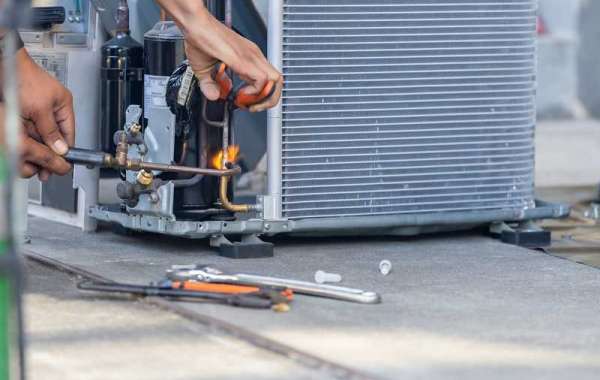Heating and cooling systems, also known as HVAC (heating, ventilation, and air conditioning) systems, come in different types and configurations. Understanding the most common HVAC system types and their applications will help you choose the right system for your home or building needs. Experience superior comfort and energy efficiency with our expert HVAC installation services.
Packaged Systems
Packaged HVAC systems contain heating and cooling components all in one cabinet unit. They come in a range of sizes to accommodate different home and business needs. Packaged units often sit outside the building they serve, either on a rooftop or at ground level.
Packaged heat pump systems provide both heating and cooling. They work by moving heat between the indoors and outdoors. In the winter, the outdoor heat pump unit takes heat from the outside air and pumps it indoors. In the summer, it does the reverse, absorbing heat from the indoor air and discharging it outside.
Gas packaged units utilize a gas furnace for heating and an air conditioner for cooling. Electric packaged systems use electric heating and cooling components. Packaged electric/gas units combine gas heating with electric cooling.
Advantages of packaged systems:
- All-in-one box makes installation simple. Just mount the exterior unit and connect ductwork.
- Good for small to mid-size homes and buildings. Available in sizes from 1.5 to 5 tons of cooling.
- Provide zoned heating and cooling when multi-zone dampers are added.
Disadvantages:
- Larger units can be noisy outside due to the fan.
- Ventilation must be added separately.
- Repairs usually require removing the entire cover rather than just accessing individual components.
Split HVAC Systems
Split HVAC systems separate the outdoor condenser/compressor from the indoor air handling system. This allows for quieter indoor units and more flexibility for installation.
The outdoor condenser houses the compressor and cooling coil. The indoor air handler contains a supply blower and the evaporator coil. In heating mode, the unit heats the air via electrical heating coils or a gas furnace.
Split system types include
- Air-source heat pumps provide heating and cooling. Reversing valves switch modes between the indoor and outdoor heat exchange.
- Central air conditioners provide cooling only. Must be paired with a gas or electric furnace for heating.
- Dual-fuel systems combine an electric heat pump with a gas furnace backup. The system chooses the more economical heating option.
Advantages of split HVAC systems:
- Allow for quieter and more visually appealing indoor units.
- Flexible installation - the condenser can go on a roof while the air handler goes in a closet or attic.
- Available in a wide range of sizes for larger homes and buildings.
- Components can be repaired or replaced individually without replacing entire system.
Disadvantages:
- Installation is more complex, requiring connecting refrigerant lines and wiring between the indoor and outdoor units.
- Separate ventilation must still be added.
Ductless Mini-Split Systems
Ductless mini-split systems provide zoned heating and cooling without ductwork running through the building. An outdoor compressor connects to one or more slim wall or ceiling indoor units mounted in different rooms.
Quiet variable-speed fans in the indoor units circulate air. Refrigerant tubes and wires connect the outdoor and indoor units. The systems use a smart controller to direct warming or cooling to each indoor unit based on the zone's temperature.
Advantages of ductless mini-splits:
- Provide quiet, focused heating and cooling to specific rooms without ducts.
- Flexible - indoor units mount on walls, ceilings, or floors.
- Efficient - only heat or cool occupied rooms.
- Allows lower heating and cooling costs for additions and renovations.
Disadvantages:
- Upfront cost is higher than installing a single central system.
- Most models still need separate ventilation.
- Unit appearance may be a concern in some decorative spaces.
Forced Air HVAC Systems
Forced air systems utilize ducts and vents to distribute heated or cooled air throughout a building. A central furnace heats the air while an air conditioning coil cools it. Supply and return ducts form a closed loop to re-circulate the air.
Basic forced air system components include:
- Air handler unit - contains blower, cooling coil, and possibly the furnace
- Supply ducts - insulated ducts distribute air from the handler to vents in each room
- Return ducts: ducts that bring air back to the handler to be heated/cooled again
- Registers, grilles, diffusers - vents that disperse or collect air in each room
Advantages include:
- Provides whole-building heating and cooling from one central unit and duct system.
- Flexible, zoned distribution when zone dampers are added in the ducts.
- Components are widely available and contractors are familiar with installation.
Disadvantages:
- Duct losses can reduce efficiency. Proper duct sealing is essential.
- Airborne dust and allergens can circulate through the whole building.
- Central furnace or coil breakdown affects the entire building.
Hydronic Heating Systems
Hydronic heating systems use water or a water-based solution as the heating medium instead of air. Hydronic heat is generated by a boiler and distributed through pipes to hydronic heat emitters.
Common heat emitters include:
- Baseboard radiators
- Radiant floor tubing
- Radiant wall or ceiling panels
- Fan coil units (like a furnace but uses hot water)
Advantages of hydronic heat:
- Even, comfortable radiant heating.
- Zoned heating - each room can have its own temperature.
- Boilers can use gas, oil, electricity, solar thermal, or other heat sources
- Ability to tie domestic hot water into the system.
- Long lifespan - pipes and radiators can last 50 years or more.
Disadvantages:
- Higher installation cost due to piping and radiators.
- Need separate ducted systems for cooling and ventilation.
- Boiler breakdown affects heat for the whole building.
Choosing the Right System
When selecting an HVAC system, consider factors like your climate zone, utility costs, home/building size, construction type, and budget. Cooling-dominated climates and larger buildings often benefit from central forced air or split systems. Hydronic and mini-splits work well for smaller spaces and additions. Upfront cost, operating cost, maintenance, comfort, and longevity are all important considerations. With an understanding of the most common HVAC system types, you can make the heating and cooling choice that best fits your home or building.










